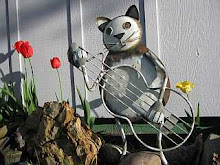 Since my return to Montana was delayed I decided to fix a corroded pipe that goes to my brother's hot water heater.
Since my return to Montana was delayed I decided to fix a corroded pipe that goes to my brother's hot water heater.It is the pipe on the right - the cold water pipe. The pipe on the left - the hot water pipe - has corrosion on it but the leak that caused that corrosion stopped and dried up some time ago. The cold water pipe is still damp in a small spot.
I took the photo after I removed most of the corrosion from the pipe. Yes, I say 'after'. The corrosion was so thick that it completely covered the short piece of pipe that rises from the hot water heater to the first coupling. The corrosion had increased in width from the coupler to the top of the hot water heater.
I think the leak originated from the shut off handle, which can be seen near the hot water heater vent. That made replacing the pipe trickier as I had to shut off water to the entire house and not just to the hot water heater as the shut off valve also needed to be replaced.
Another challenge was that I had to remove the vent that goes from the hot water heater to the furnace vent. Before the vent could be removed I had to turn off the hot water heater and the furnace too. Turning the furnace off when the temperature outside is in the single digits Fahrenheit is not ideal.
Initially I tried to turn off the value in the photo so I could work on the union joint first. But the handle was so corroded I couldn't turn it. Ok. Turn off the water to the entire house, open the faucets to drain as much water from the pipes as I could. And wait while the water slowly drains.
Once the hot water heater vent was removed I tried to undo the union. Nope. It was so corroded that it wouldn't budge. The best way to start removing the pipe was to cut it. Because the corrosion started below the top of the shut off value I had no worries about removing the valve. However, I had concerns that the coupler was so corroded that I wouldn't be able to remove it and the lower part of the pipe without damaging the pipe as it goes into the hot water heater.
So I punted. The pipe is only damp in such a small spot I can wait. Come Spring, when the furnace is no longer needed, my brother plans to hire a plumber. That way if the hot water heater gets damaged the plumber can handle installing a new one. I don't want to deal with installing the hot water heater as it is a natural gas heater and I feel better if a professional handles those pipes.


No comments:
Post a Comment